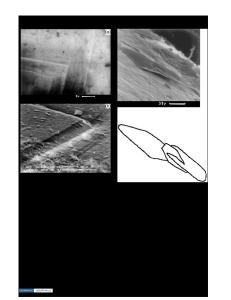Growth twins in Bi 2 Ca 1 Sr 2 Cu 2 O 8 superconductor single crystals
- PDF / 663,564 Bytes
- 4 Pages / 593.28 x 841.68 pts Page_size
- 82 Downloads / 367 Views
Growth twins in Bi2CaiSr2Cu2O8 superconductor single crystals P.D. Han, A. Asthana, Z. Xu, and D.A. Payne Department of Materials Science and Engineering, Materials Research Laboratory, and Science and Technology Center for Superconductivity, University of Illinois at Urbana-Champaign, Rlinois 61801 (Received 20 December 1989; accepted 7 February 1990)
Large-scale twin structures in single crystal Bi2CaiSr2Cu2O8 (2122) are reported for the first time. Symmetrical 90° (i.e., a-b) twins with a [110] type twin boundary were observed. A characteristic layer-growth morphology and jagged twin walls suggest that twin formation occurred layer by layer during crystal growth; i.e., the twins were growth twins. Hot-stage optical microscopy, x-ray diffraction, and electron microscopy results are discussed with reference to twin morphology.
Several families of high temperature superconductors (e.g., Y-Ba-Cu-O, Bi-Ca-Sr-Cu-O, and Tl-BaSr-Cu-O) have recently been discovered. A common feature is 2-dimensional layer growth with strong anisotropic properties. A basic understanding of crystallization and growth processes for large superconducting crystals is an important and challenging problem, both from theoretical and practical considerations. From this point of view, an interesting question is the role played by twins in the growth and properties of superconducting crystals. In the Bi-superconductor family, three related phases in the homologous series Bi2Can_iSr2CunO2n+4 have been identified. In this communication, we report on the existence of largescale twin structures in single crystals of the 2122 phase (Bi 2 CaiSr 2 Cu2O8, n = 2). Hot-stage optical microscopy, x-ray diffraction, and electron microscopy determined that twinning in the Bi-superconductor was substantially different from YBCO. For 2122, the twins were growth twins, which result from a strong layergrowth habit. In contrast, the twins in YBCO are transformation twins which can be swept out by a directed stress near the transformation temperature.1 In the YBCO system, the superconducting orthorhombic phase contains ultrafine (10-50 nm wide) twin lamellae in the [110] direction.2'3 Twinning is related to a tetragonal-orthorhombic phase transformation on cooling with absorption of oxygen.4'5 The three superconducting phases in the BCSCO system have orthorhombic structures and are likely to exhibit (110) twins similar to YBCO. Single crystals of 2122 have been grown by a variety of methods.6 10 To date, large-scale twinning has not been observed in 2122 single crystals. High resolution TEM has identified fine-scale twinning J. Mater. Res., Vol. 5, No. 5, May 1990
http://journals.cambridge.org
Downloaded: 15 Mar 2015
in 2122 polycrystals.1112 In this report we now give evidence for growth twins in single crystal 2122. Single crystals were grown by a flux method.13 The starting composition was l/2Bi 2 O 3 :CaCO 3 :SrCO3: CuO = 2:1.2:2:2.6. This composition gave good superconducting crystals with no detectable intergrowths of any lower Tc phase. Single crystals (of
Data Loading...











